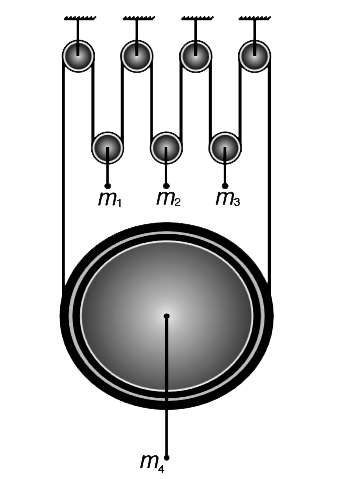If m1=10kg,m2=4kg,m3=2kg, the acceleration of system is

5g/2
5g/3
5g/8
5g/14
The correct Answer is:C
F=ma,m1−T1=m1a,T1+m2gsinθ−T2=m2a
T2−m2g=m3a
Topper's Solved these Questions
- LAW OF MOTIONBOOK - NARAYNACHAPTER - LAW OF MOTIONEXERCISE - EXERCISE - II (C.W)(LAW OF CONSERVATION OF MOMENTUM)
4 Videos
- LAW OF MOTIONBOOK - NARAYNACHAPTER - LAW OF MOTIONEXERCISE - EXERCISE - II (C.W)(EQUILIBRIUM OF A PARTICLE)
3 Videos
- LAW OF MOTIONBOOK - NARAYNACHAPTER - LAW OF MOTIONEXERCISE - EXERCISE - II (C.W)(IMPULSE)
2 Videos
- KINETIC THEORY OF GASESBOOK - NARAYNACHAPTER - KINETIC THEORY OF GASESEXERCISE - LEVEL-III(C.W)
52 Videos
- MATHEMATICAL REVIEW & PHYSICAL WORLDBOOK - NARAYNACHAPTER - MATHEMATICAL REVIEW & PHYSICAL WORLDEXERCISE - C.U.Q
13 Videos
Similar Questions
In fig. both pulleys and the string are massless and all the surfaces are frictionless.

Given m1=1kg,m2=2kg,m3=3kg.
The acceleration of m3 is
View SolutionIn fig. both pulleys and the string are massless and all the surfaces are frictionless.

Given m1=1kg,m2=2kg,m3=3kg.
The acceleration of m1 is
View Solution
Knowledge Check
In fig. both pulleys and the string are massless and all the surfaces are frictionless.

Given m1=1kg,m2=2kg,m3=3kg.
The acceleration of m3 isA407ms−2B307ms−2C207ms−2DNone of theseIn fig. both pulleys and the string are massless and all the surfaces are frictionless.

Given m1=1kg,m2=2kg,m3=3kg.
The acceleration of m1 isA407ms−2B307ms−2C207ms−2D√17g7ms−2Three blocks of masses m1,m2andm3 are connected by a massless string as shown in figure on a frictionless table. They are pulled with a force T3=40N. If m1=10kg,m2=6kgandm3=4kg, then tension T2 will be
 A10 NB20 NC32 ND40N
A10 NB20 NC32 ND40N
mA=1kg,mB=2kg,mC=10kg

View SolutionThree blocks are connected by strings as shown in and are pulled by a force T3=60N if m1=10kg,m2=20 kg and m3=30kg calculate the acceleration of the system and T1andT2

View SolutionIn the system shown in fig., all pulleys are mass less and the string is inextensible and light.
(a) After the system is released, find the acceleration of mass m1
(b) If m1=1kg,m2=2kgandm3=3kg then what must be value of mass m4 so that it accelerates downwards?

View SolutionTwo masses m1 and m2 are attached to a string which passes over a frictionless smooth pulley. When m1=10kg,m2=6kg, the acceleration of masses is

View SolutionThree block of masses m1,m2&M3 are connected by mass less stings as shown on a frictionless table.

They are pulled with a force T3=40N, If m1=10kg,m2=6kg&m3=4kg, then tension T2 will be
View Solution
